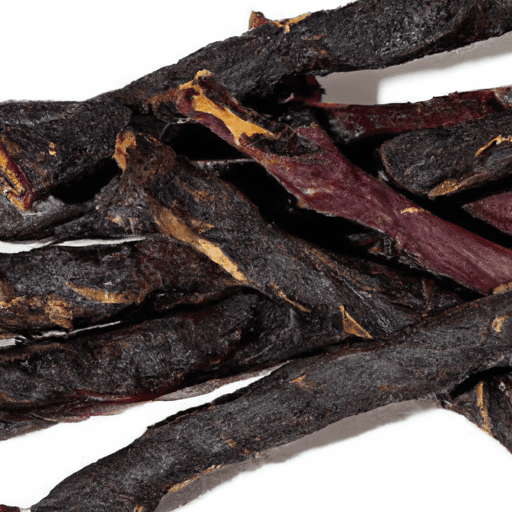Exploring the World of Biltong: A Culinary Delight
Biltong, a staple in South African cuisine, is the perfect example of how preservation methods can turn a simple cut of meat into a mouthwatering delight. This air-dried, cured beef delicacy has a rich history, a distinctive savory taste, and a myriad of culinary applications that continue to captivate food enthusiasts around the globe.
The Origin Story
With its roots deeply embedded in African culinary traditions, biltong has a fascinating history that dates back centuries. The word “biltong” itself is derived from the Dutch words “bil” (meaning buttock or hindquarter) and “tong” (meaning strip or tongue). Originally, biltong was created as a means of preserving meat in the dry, arid regions of South Africa. Throughout the centuries, the recipe evolved, and today, biltong is enjoyed not just in South Africa but worldwide.
A Flavor Explosion
Biltong’s taste is unique and unforgettable. Its intense umami flavor is achieved through the perfect balance of salt, spices, and the natural characteristics of the beef. The beef is cut into thin strips and marinated in a blend of vinegar, salt, and a secret combination of spices which commonly include coriander, black pepper, and dried herbs. The meat is then left to air dry, allowing for the flavors to intensify and develop over time. The end result? A tender, flavorful treat that leaves taste buds tingling with delight.
Culinary Applications
While biltong is often enjoyed as a snack on its own, it is also a versatile ingredient that can elevate a variety of dishes. Its bold, savory taste adds depth of flavor and texture to numerous culinary creations. Here are some popular ways to use biltong in cooking:
Charcuterie and Cheese Boards: Biltong’s intense flavor makes it a fantastic addition to charcuterie and cheese boards. Its rich meaty taste complements an array of cheeses, fruits, and nuts, creating a truly indulgent experience.
Salads: Adding biltong to salads provides a protein-packed, flavorful twist to the classic greens and vegetables. Its unique texture brings a satisfying chewiness, while its intense taste acts as a show-stopper in salad bowls.
Sandwiches and Wraps: Whether you’re making a classic sandwich or a wrap, biltong can take it to the next level. The combination of the cured meat and various fillings creates a burst of delectable flavors that will leave you wanting more.
Pasta and Rice Dishes: Biltong can be incorporated into pasta and rice dishes, adding a new dimension to these comforting meals. From biltong carbonara to spicy biltong fried rice, the culinary possibilities are endless.
Nutritional Value
Apart from being incredibly delicious, biltong also offers a range of nutritional benefits. This cured meat is made from lean cuts of beef, making it a great source of high-quality protein. It is also low in carbohydrates and contains important minerals such as iron and zinc. However, it’s essential to consume biltong in moderation due to its high sodium content.
Biltong, a Worldly Delicacy
As biltong continues to gain popularity outside of its South African origins, it’s become a sought-after delicacy in many countries. Food enthusiasts are drawn to its unique taste, versatile nature, and the rich cultural history it represents. So whether you’re enjoying it as a standalone snack, adding it to dishes, or exploring its potential in new culinary ventures, biltong is sure to provide a satisfying experience for the curious palate.
Discover the world of biltong today and indulge in this exceptional meaty treat that transcends cultural boundaries and brings people together through the love of good food.
Sure! Here are some interesting facts about biltong:
Origin: Biltong is a popular dried meat originating from Southern Africa. It has its roots in the traditional preservation methods used by the indigenous tribes of the region, who would air-dry meat to make it last longer in the hot and arid climate.
Common uses: Biltong is commonly enjoyed as a snack or as part of a meal. It can be eaten on its own or used as an ingredient in salads, sandwiches, wraps, and stews. Biltong is often sliced thinly and enjoyed as a high-protein snack.
Types of meat: Traditional biltong was made using various types of meat, such as beef, game, and ostrich. Nowadays, biltong is most commonly made from beef, although other meats like venison or poultry can also be used.
Drying process: Biltong is made by marinating strips of meat in a mixture of vinegar, salt, and spices, which helps to preserve the meat and enhance the flavor. The marinated meat is then air-dried for several days, allowing it to develop a chewy texture and rich flavor.
Nutritional benefits: Biltong is a good source of high-quality protein, providing essential amino acids necessary for muscle growth and repair. It is also low in carbohydrates and rich in vitamins and minerals like iron, zinc, and B-vitamins.
Unique properties: Biltong has a distinct flavor profile, with a blend of saltiness and spiciness. It is often seasoned with a mix of herbs and spices, such as coriander, black pepper, and paprika. The drying process gives biltong a concentrated meaty flavor, comparable to jerky but with a different texture.
Historical significance: Biltong has a long history in Southern African cuisine and was originally developed as a way to preserve meat in a time before refrigeration. Many indigenous tribes used similar methods to preserve meat, ensuring a steady supply of food when hunting was not possible.
Remember to store biltong in a cool, dry place, as moisture can affect its texture and spoilage.




Use the share button below if you liked it.
It makes me smile, when I see it.